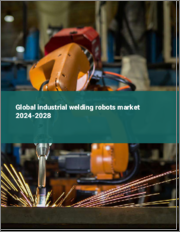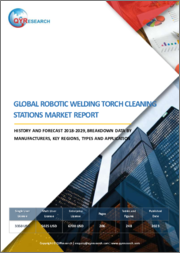
|
시장보고서
상품코드
1614863
로봇 용접 시장 규모, 점유율, 성장 분석 : 유형별, 적재량별, 컴포넌트별, 최종사용자 산업별, 용도별, 지역별) - 산업 예측(2024-2031년)Robotic Welding Market Size, Share, Growth Analysis, By Type (Arc Welding, Spot Welding), By Payload Capacity, By Component, By End User Industry, By Application, By Region - Industry Forecast 2024-2031 |
||||||
세계의 로봇 용접 시장 규모는 2022년에 65억 달러로 평가되며, 2023년 70억 8,000만 달러에서 2031년에는 140억 달러로 성장하며, 예측 기간(2024-2031년)의 CAGR은 8.9%로 성장할 전망입니다.
세계의 로봇 용접 시장은 자동화의 발전과 다양한 산업 분야에서 효율적이고 정밀한 용접 솔루션에 대한 수요 증가에 힘입어 빠르게 성장하고 있습니다. 용접에 사용되는 프로그래머블 로봇은 생산성과 품질을 향상시키고 인건비를 절감할 수 있습니다. 첨단 센서와 AI 구동 기능을 갖춘 산업용 로봇의 채택이 제조업에서 증가하고 있으며, 이는 빠르고 정확한 작업을 가능하게 하는 이러한 추세의 주요 원동력이 되고 있습니다. 자동차 산업은 자동차 생산에 일관되고 정확한 용접을 필요로 하는 주요 수요처로 두드러집니다. 또한 건설 분야는 대규모 프로젝트의 효율성을 높이기 위해 로봇 용접을 활용하고 있습니다. 아시아태평양은 중국, 일본, 한국의 탄탄한 제조업에 힘입어 시장을 주도하고 있으며, 다양한 기관에서 시행하는 안전 규정이 이러한 시스템의 안전한 통합을 보장하고 있습니다.
목차
서론
- 분석 목적
- 시장 범위
- 정의
분석 방법
- 정보 조달
- 2차·1차 데이터 방법
- 시장 규모 예측
- 시장의 상정과 제한
개요
- 시장의 개요와 전망
- 수급 동향 분석
- 부문별 기회 분석
시장 역학과 전망
- 시장 개요
- 시장 규모
- 시장 역학
- 촉진요인과 기회
- 억제요인과 과제
- Porter의 산업 분석과 영향
- 경쟁 기업 간 경쟁 관계
- 대체품의 위협
- 바이어의 교섭력
- 신규 진출업체의 위협
- 공급 기업의 교섭력
주요 시장 인사이트
- 주요 성공 요인
- 경쟁의 정도
- 주요 투자 기회
- 시장 에코시스템
- 시장의 매력 지수(2023년)
- PESTEL 분석
- 거시경제 지표
- 밸류체인 분석
- 가격 분석
- 기술의 진보
- 규제 상황
- 사례 연구
세계의 로봇 용접 시장 규모·CAGR : 유형별(2024-2031년)
- 시장 개요
- 아크 용접
- MIG(금속 불활성 가스) 용접
- TIG(텅스텐 불활성 가스) 용접
- 플라즈마 아크 용접
- 스폿 용접
- 저항 스폿 용접
- 프로젝션 용접
- 레이저 용접
- CO2 레이저 용접
- 파이버 레이저 용접
- 기타
- 초음파 용접
- 전자빔 용접
세계의 로봇 용접 시장 규모·CAGR : 적재량별(2024-2031년)
- 시장 개요
- 저적재량
- 소형 부품 용접
- 경조립 용접
- 중적재량
- 일반 제조업
- 자동차 부품
- 고적재량
- 중기
- 대형 구조 부품
세계의 로봇 용접 시장 규모·CAGR : 컴포넌트별(2024-2031년)
- 시장 개요
- 하드웨어
- 로봇 암
- 용접 토치
- 포지셔너
- 소프트웨어
- 프로그래밍 소프트웨어
- 시뮬레이션 소프트웨어
- 서비스
- 설치 서비스
- 정비 서비스
- 트레이닝 서비스
세계의 로봇 용접 시장 규모·CAGR : 용도별(2024-2031년)
- 시장 개요
- 자동차 산업
- 보디 인 화이트 용접
- 섀시 용접
- 설비·기계 산업
- 중기 용접
- 정밀 기계 용접
- 선박 산업
- 선체 용접
- 데크 용접
- 항공우주·방위
- 기체 용접
- 방위 차량 용접
- 건설
- 철골 용접
- 교량 용접
- 일렉트로닉스 산업
- 회로 기판 용접
- 부품 조립 용접
세계의 로봇 용접 시장 규모·CAGR(2024-2031년)
- 북미
- 미국
- 캐나다
- 유럽
- 영국
- 독일
- 스페인
- 프랑스
- 이탈리아
- 기타 유럽 지역
- 아시아태평양
- 중국
- 인도
- 일본
- 한국
- 기타 아시아태평양
- 라틴아메리카
- 브라질
- 기타 라틴아메리카 지역
- 중동 및 아프리카
- GCC 국가
- 남아프리카공화국
- 기타 중동 및 아프리카
경쟁 구도
- 상위 5사의 비교
- 주요 기업의 시장 포지셔닝(2023년)
- 주요 기업이 채택한 전략
- 시장의 최근 동향
- 주요 기업의 시장 점유율(2023년)
- 주요 기업의 개요
- 기업 개요
- 제품 포트폴리오 분석
- 부문별 점유율 분석
- 매출의 전년대비 비교(2021-2023년)
주요 기업 개요
- FANUC Corporation
- YASKAWA Electric Corporation
- KUKA AG
- ABB
- Kawasaki Heavy Industries, Ltd.
- Panasonic Corporation
- DAIHEN Corporation
- NACHI-FUJIKOSHI CORP.
- Comau S.p.A.
- Hyundai Robotics
- The Lincoln Electric Company
- Shenyang SIASUN Robot
- Miller Electric Mfg. LLC
- Kemppi Oy
- IGM ROBOTERSYSTEME AG
- DENSO Corporation
- Abhisha Technocrats Pvt. Ltd.
- Siasun Robot & Automation Co Ltd.
- Atlas Copco
- Universal Robots
결론과 권장사항
KSA 25.01.02Global Robotic Welding Market size was valued at USD 6.50 billion in 2022 and is poised to grow from USD 7.08 billion in 2023 to USD 14.00 billion by 2031, growing at a CAGR of 8.9% during the forecast period (2024-2031).
The global robotic welding market is experiencing rapid growth, propelled by advancements in automation and a heightened demand for efficient, precise welding solutions across diverse industries. Programmable robots used in welding enhance productivity, quality, and reduce labor costs. The manufacturing sector's increased embrace of industrial robots, equipped with sophisticated sensors and AI-driven capabilities, is a primary driver of this trend, allowing for high-speed, accurate operations. The automotive industry stands out as a major consumer, requiring consistent and precise welding for vehicle production. Additionally, the construction sector is leveraging robotic welding for large-scale project efficiency. Asia Pacific leads the market, backed by robust manufacturing in China, Japan, and South Korea, while safety regulations enforced by various organizations ensure the safe integration of these systems.
Top-down and bottom-up approaches were used to estimate and validate the size of the Global Robotic Welding market and to estimate the size of various other dependent submarkets. The research methodology used to estimate the market size includes the following details: The key players in the market were identified through secondary research, and their market shares in the respective regions were determined through primary and secondary research. This entire procedure includes the study of the annual and financial reports of the top market players and extensive interviews for key insights from industry leaders such as CEOs, VPs, directors, and marketing executives. All percentage shares split, and breakdowns were determined using secondary sources and verified through Primary sources. All possible parameters that affect the markets covered in this research study have been accounted for, viewed in extensive detail, verified through primary research, and analyzed to get the final quantitative and qualitative data.
Global Robotic Welding Market Segmental Analysis
Global Robotic Welding Market is segmented by type, payload capacity, component, end user industry, application and region. Based on type, the market is segmented into arc welding (MIG (metal inert gas) welding, tig (tungsten inert gas) welding, plasma arc welding), spot welding (resistance spot welding, projection welding), laser Welding (CO2 laser welding, fiber laser welding) and others (ultrasonic welding, electron beam welding). Based on payload capacity, the market is segmented into low payload (small parts welding, light assembly welding), medium payload (general manufacturing, automotive components) and high payload (heavy machinery, large structural components). Based on component, the market is segmented into hardware (robotic arms, welding torches, positioners), software (programming software, simulation software) and services (installation services, maintenance services, training services). Based on application, the market is segmented into Automotive Industry, Equipment & Machinery Industry, Ship Industry, Aerospace & Defense, Construction, Electronics Industry. Based on region, the market is segmented into North America, Europe, Asia Pacific, Latin America and Middle East & Africa.
Driver of the Global Robotic Welding Market
One of the significant factors fueling the expansion of the global robotic welding market is the rising need for enhanced productivity and efficiency in welding operations across multiple sectors. Industries are increasingly recognizing that robotic welding systems deliver notable benefits, including superior precision, shorter cycle times, and decreased labor expenses. As manufacturers seek to boost their operational capabilities and streamline production processes, the integration of robotic welding technology emerges as an attractive solution to address these requirements. Consequently, this trend stimulates further investment and growth within the robotic welding market, paving the way for its continued advancement.
Restraints in the Global Robotic Welding Market
A notable challenge in the global robotic welding market is the substantial initial investment required for the deployment of robotic welding systems. The expenses associated with purchasing, installing, and integrating robotic equipment can be quite high, posing a significant obstacle, especially for small to medium-sized enterprises. Beyond the initial costs, ongoing financial commitments for maintenance, training, and programming further increase the overall expenditure. Such financial constraints can inhibit many companies from embracing robotic welding technology, ultimately restricting market growth, particularly in regions or industries that are particularly sensitive to costs. Therefore, addressing these investment-related barriers is crucial for enhancing market adoption.
Market Trends of the Global Robotic Welding Market
The global robotic welding market is witnessing a significant trend towards the integration of advanced technologies, notably artificial intelligence (AI) and machine learning (ML). These innovations allow for dynamic adaptation to varying welding parameters, optimizing operational efficiency and enhancing system capabilities. With AI and ML facilitating real-time monitoring, fault detection, and predictive maintenance, manufacturers experience elevated productivity and minimized downtime. Additionally, these technologies bolster quality control, ensuring superior weld integrity. This trend not only augments the performance of robotic welding systems but also sets the stage for transformative advancements in the market, aligning with the ever-evolving demands of modern manufacturing environments.
Table of Contents
Introduction
- Objectives of the Study
- Scope of the Report
- Definitions
Research Methodology
- Information Procurement
- Secondary & Primary Data Methods
- Market Size Estimation
- Market Assumptions & Limitations
Executive Summary
- Global Market Outlook
- Supply & Demand Trend Analysis
- Segmental Opportunity Analysis
Market Dynamics & Outlook
- Market Overview
- Market Size
- Market Dynamics
- Driver & Opportunities
- Restraints & Challenges
- Porters Analysis & Impact
- Competitive rivalry
- Threat of substitute
- Bargaining power of buyers
- Threat of new entrants
- Bargaining power of suppliers
Key Market Insights
- Key Success Factors
- Degree of Competition
- Top Investment Pockets
- Market Ecosystem
- Market Attractiveness Index, 2023
- PESTEL Analysis
- Macro-Economic Indicators
- Value Chain Analysis
- Pricing Analysis
- Regulatory Landscape
- Patent Analysis
- Case Studies
Global Robotic Welding Market Size by Type & CAGR (2024-2031)
- Market Overview
- Arc Welding
- MIG (Metal Inert Gas) Welding
- TIG (Tungsten Inert Gas) Welding
- Plasma Arc Welding
- Spot Welding
- Resistance Spot Welding
- Projection Welding
- Laser Welding
- CO2 Laser Welding
- Fiber Laser Welding
- Others
- Ultrasonic Welding
- Electron Beam Welding
Global Robotic Welding Market Size by Payload Capacity & CAGR (2024-2031)
- Market Overview
- Low Payload
- Small Parts Welding
- Light Assembly Welding
- Medium Payload
- General Manufacturing
- Automotive Components
- High Payload
- Heavy Machinery
- Large Structural Components
Global Robotic Welding Market Size by Component & CAGR (2024-2031)
- Market Overview
- Hardware
- Robotic Arms
- Welding Torches
- Positioners
- Software
- Programming Software
- Simulation Software
- Services
- Installation Services
- Maintenance Services
- Training Services
Global Robotic Welding Market Size by Application & CAGR (2024-2031)
- Market Overview
- Automotive Industry
- Body-in-White Welding
- Chassis Welding
- Equipment & Machinery Industry
- Heavy Equipment Welding
- Precision Machinery Welding
- Ship Industry
- Hull Welding
- Deck Welding
- Aerospace & Defense
- Aircraft Frame Welding
- Defense Vehicle Welding
- Construction
- Steel Frame Welding
- Bridge Welding
- Electronics Industry
- Circuit Board Welding
- Component Assembly Welding
Global Robotic Welding Market Size & CAGR (2024-2031)
- North America (Type, Payload Capacity, Component, End User Industry, Application)
- US
- Canada
- Europe (Type, Payload Capacity, Component, End User Industry, Application)
- UK
- Germany
- Spain
- France
- Italy
- Rest of Europe
- Asia-Pacific (Type, Payload Capacity, Component, End User Industry, Application)
- China
- India
- Japan
- South Korea
- Rest of Asia Pacific
- Latin America (Type, Payload Capacity, Component, End User Industry, Application)
- Brazil
- Rest of Latin America
- Middle East & Africa (Type, Payload Capacity, Component, End User Industry, Application)
- GCC Countries
- South Africa
- Rest of Middle East & Africa
Competitive Intelligence
- Top 5 Player Comparison
- Market Positioning of Key Players, 2023
- Strategies Adopted by Key Market Players
- Recent Developments in the Market
- Company Market Share Analysis, 2023
- Company Profiles of All Key Players
- Company Details
- Product Portfolio Analysis
- Company's Segmental Share Analysis
- Revenue Y-O-Y Comparison (2021-2023)
Key Company Profiles
- FANUC Corporation
- Company Overview
- Business Segment Overview
- Financial Updates
- Key Developments
- YASKAWA Electric Corporation
- Company Overview
- Business Segment Overview
- Financial Updates
- Key Developments
- KUKA AG
- Company Overview
- Business Segment Overview
- Financial Updates
- Key Developments
- ABB
- Company Overview
- Business Segment Overview
- Financial Updates
- Key Developments
- Kawasaki Heavy Industries, Ltd.
- Company Overview
- Business Segment Overview
- Financial Updates
- Key Developments
- Panasonic Corporation
- Company Overview
- Business Segment Overview
- Financial Updates
- Key Developments
- DAIHEN Corporation
- Company Overview
- Business Segment Overview
- Financial Updates
- Key Developments
- NACHI-FUJIKOSHI CORP.
- Company Overview
- Business Segment Overview
- Financial Updates
- Key Developments
- Comau S.p.A.
- Company Overview
- Business Segment Overview
- Financial Updates
- Key Developments
- Hyundai Robotics
- Company Overview
- Business Segment Overview
- Financial Updates
- Key Developments
- The Lincoln Electric Company
- Company Overview
- Business Segment Overview
- Financial Updates
- Key Developments
- Shenyang SIASUN Robot
- Company Overview
- Business Segment Overview
- Financial Updates
- Key Developments
- Miller Electric Mfg. LLC
- Company Overview
- Business Segment Overview
- Financial Updates
- Key Developments
- Kemppi Oy
- Company Overview
- Business Segment Overview
- Financial Updates
- Key Developments
- IGM ROBOTERSYSTEME AG
- Company Overview
- Business Segment Overview
- Financial Updates
- Key Developments
- DENSO Corporation
- Company Overview
- Business Segment Overview
- Financial Updates
- Key Developments
- Abhisha Technocrats Pvt. Ltd.
- Company Overview
- Business Segment Overview
- Financial Updates
- Key Developments
- Siasun Robot & Automation Co Ltd.
- Company Overview
- Business Segment Overview
- Financial Updates
- Key Developments
- Atlas Copco
- Company Overview
- Business Segment Overview
- Financial Updates
- Key Developments
- Universal Robots
- Company Overview
- Business Segment Overview
- Financial Updates
- Key Developments



















